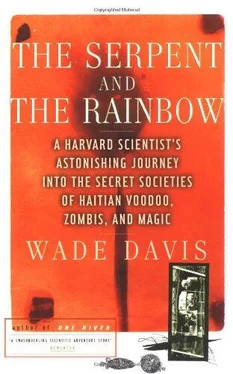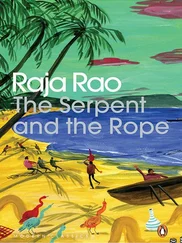Wade Davis - The Serpent and the Rainbow
Здесь есть возможность читать онлайн «Wade Davis - The Serpent and the Rainbow» весь текст электронной книги совершенно бесплатно (целиком полную версию без сокращений). В некоторых случаях можно слушать аудио, скачать через торрент в формате fb2 и присутствует краткое содержание. Год выпуска: 1985, Издательство: Simon & Schuster, Жанр: Старинная литература, на английском языке. Описание произведения, (предисловие) а так же отзывы посетителей доступны на портале библиотеки ЛибКат.
- Название:The Serpent and the Rainbow
- Автор:
- Издательство:Simon & Schuster
- Жанр:
- Год:1985
- ISBN:нет данных
- Рейтинг книги:5 / 5. Голосов: 1
-
Избранное:Добавить в избранное
- Отзывы:
-
Ваша оценка:
- 100
- 1
- 2
- 3
- 4
- 5
The Serpent and the Rainbow: краткое содержание, описание и аннотация
Предлагаем к чтению аннотацию, описание, краткое содержание или предисловие (зависит от того, что написал сам автор книги «The Serpent and the Rainbow»). Если вы не нашли необходимую информацию о книге — напишите в комментариях, мы постараемся отыскать её.
The Serpent and the Rainbow — читать онлайн бесплатно полную книгу (весь текст) целиком
Ниже представлен текст книги, разбитый по страницам. Система сохранения места последней прочитанной страницы, позволяет с удобством читать онлайн бесплатно книгу «The Serpent and the Rainbow», без необходимости каждый раз заново искать на чём Вы остановились. Поставьте закладку, и сможете в любой момент перейти на страницу, на которой закончили чтение.
Интервал:
Закладка:
The nation that emerged from the revolutionary era was a pariah in the eyes of the international community. With the exception of Liberia, which was a limp creation of the United States, Haiti ranked as the only independent black republic for a hundred years. Its very existence was a constant thorn in the side of an imperialistic age. The Haitian government irritated the European powers by actively supporting revolutionary struggles that vowed to eliminate slavery. Simon Bolívar, for example, was both sheltered there and funded before he liberated Venezuela and the other Spanish colonies. In a more symbolic gesture, the government purchased shipments of slaves en route to the United States only to grant them freedom. Moreover, Haiti defied international commercial interests by prohibiting any foreigner from owning land or property within the country. By no means did this law bring trade to a standstill, but it dramatically modified its nature. In a century wherein European capital moved into virtually all regions of the world, Haiti remained relatively immune. Even the hegemony of the Roman Catholic church was checked. The clergy, which had never had a particularly strong presence in colonial days, lost virtually all influence after the revolution. In fact, for the first half-century of Haiti’s independence, there was an official schism between the country and the Vatican. Roman Catholicism remained the official religion of the emerging political and economic elite, but during the seminal years of the nation, the church had practically no presence in the countryside.
Within Haiti, isolation of a different form occurred. Throughout the nineteenth century, as the colonial infrastructure of roads decayed and was not replaced, the physical gap between town and country widened. This, in turn, sharpened an emerging cultural hiatus between two radically different segments of Haitian society, the rural peasants and the urban elite. The former, of course, were ex-slaves; the latter, in part, descendants of a special class of free mulattos that during the colonial era had enjoyed both great wealth and all the rights of French citizens, including the ignoble privilege of owning slaves. During the early years of the independence, the obvious differences between these two groups crystallized into a profound separation that went far deeper than mere class lines. They became more like two different worlds, coexisting within a single country.
The urban elite, though proudly Haitian, turned to Europe for cultural and spiritual inspiration. They spoke French, professed faith in the Roman Catholic church, and were well educated. Their women wore the latest Parisian fashions, and their men naturally formed the chromatic screen through which European and American commercial interests siphoned what they could of the nation’s wealth. Their young men frequently traveled abroad, for both higher training and amusement, invariably returning to fill all business and professional positions, as well as governmental and military offices. There they promulgated the official laws of the land, all of which were again based on French precedent and the Napoleonic Code. By all foreign standards, it was this small circle of friends and extended families—for the elite never numbered more than 5 percent of the population—that controlled much of the political and economic power of the nation.
In the hinterland, however, the ex-slaves created an utterly different society based not on European models, but on their own ancestral traditions. It was not, strictly speaking, an African society. Inevitably European influences were felt, and only very rarely did pure strains of specific African cultures survive or dominate. What evolved, rather, was a uniquely Haitian amalgam forged predominantly from African traits culled from many parts of that continent. Typically, its members thought of themselves less as descendants of particular tribes or kingdoms than as “ti guinin”—Children of Guinée, of Africa, the ancient homeland, a place that slowly drifted from history into the realm of myth. And, in time, what had been the collective memory of an entire disenfranchised people become the ethos of new generations, and the foundation of a distinct and persistent culture.
Today evidence of the African heritage is everywhere in rural Haiti. In the fields, long lines of men wield hoes to the rhythm of small drums, and just beyond them sit steaming pots of millet and yams ready for the harvest feast. In a roadside settlement, or lakou , near the center of the compound, a wizened old man holds court. Markets sprout up at every crossroads, and like magnets they pull the women out of the hills; one sees their narrow traffic on the trails, the billowy walk of girls beneath baskets of rice, the silhouette of a stubborn matron dragging a half-dozen donkeys laden with eggplant. There are sounds as well. The echo of distant songs, the din of the market, and the cadence of the language itself—Creole—each word truncated to fit the meter of West African speech. Each of these disparate images, of course, translates into a theme: the value of collective labor, communal land holdings, the authority of the patriarch, the dominant role of women in the market economy. And these themes, in turn, are clues to a complex social world.
Yet images alone cannot begin to express the cohesion of the peasant society; this, like a psychic education, must come in symbols, in invisible tones sensed and felt as much as observed. For in this country of survivors and spirits, the living and the dead, it is religion that provides the essential bond. Vodoun is not an isolated cult; it is a complex mystical worldview, a system of beliefs concerning the relationship between man, nature, and the supernatural forces of the universe. It fuses the unknown to the known, creates order out of chaos, renders the mysterious intelligible. Vodoun cannot be abstracted from the day-to-day lives of the believers. In Haiti, as in Africa, there is no separation between the sacred and the secular, between the holy and the profane, between the material and the spiritual. Every dance, every song, every action is but a particle of the whole, each gesture a prayer for the survival of the entire community.
The pillar of this community is the houngan. Unlike the Roman Catholic priest, the houngan does not control access to the spirit realm. Vodoun is a quintessentially democratic faith. Each believer not only has direct contact with the spirits, he actually receives them into his body. As the Haitians say, the Catholic goes to church to speak about God, the vodounist dances in the hounfour to become God. Nevertheless, the houngan’s role is vital. As a theologian he is called upon to interpret a complex body of belief, reading the power in leaves and the meaning in stones. Yet vodoun not only embodies a set of spiritual concepts, it prescribes a way of life, a philosophy and a code of ethics that regulate social behavior. As surely as one refers to Christian or Buddhist society, one may speak of vodoun society, and within that world one finds completeness: art and music, education based on the oral transmission of songs and folklore, a complex system of medicine, and a system of justice based on indigenous principles of conduct and morality. The houngan as de facto leader of this society is at once psychologist, physician, diviner, musician, and spiritual healer. As a moral and religious leader, it is he who must skillfully balance the forces of the universe and guide the play of the winds.
Within the vodoun society, there are no accidents. It is a closed system of belief in which no event has a life of its own. It was within this society that Clairvius Narcisse and Ti Femme became zombis.
“Look into the sky and what do you see?” Rachel asked, staring far into the darkness. There was a small cooking fire between us, and in the flamelit smoke her face softened, her skin flushed in copper.
Читать дальшеИнтервал:
Закладка:
Похожие книги на «The Serpent and the Rainbow»
Представляем Вашему вниманию похожие книги на «The Serpent and the Rainbow» списком для выбора. Мы отобрали схожую по названию и смыслу литературу в надежде предоставить читателям больше вариантов отыскать новые, интересные, ещё непрочитанные произведения.
Обсуждение, отзывы о книге «The Serpent and the Rainbow» и просто собственные мнения читателей. Оставьте ваши комментарии, напишите, что Вы думаете о произведении, его смысле или главных героях. Укажите что конкретно понравилось, а что нет, и почему Вы так считаете.












